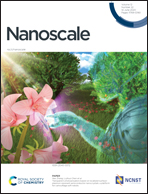Multi-component (Ag–Au–Cu–Pd–Pt) alloy nanoparticle-decorated p-type 2D-molybdenum disulfide (MoS2) for enhanced hydrogen sensing†
Abstract
Molybdenum disulfide (MoS2) has emerged as a promising material for the development of efficient sensors. Here, we have exfoliated and decorated MoS2 flakes with the novel, single-phase multi-component silver–gold–copper–palladium–platinum (Ag–Au–Cu–Pd–Pt) alloy nanoparticles, popularly named High Entropy Alloy (HEA) nanoparticles, using facile and scalable low-temperature grinding, followed by the sonochemical method. It was found that the decoration of HEA nanoparticles imparts the surface-enhanced Raman scattering effect and reduction in the work function of the material from 4.9 to 4.75 eV as measured by UV photoelectron spectroscopy. This change in the work function resulted in a Schottky barrier between the gold contact and HEA decorated MoS2 flakes as a result of drastic changes in the surface chemical non-stoichiometry. The response to hydrogen gas was studied at temperatures in the range of 30 to 100 °C, and it showed an unusual p-type nature due to surface-adsorbed oxygen species. The nanoscale junction formed between HEA and MoS2 showed a ten-time increase in the response towards hydrogen gas at 80 °C. The experimental observations have been explained with DFT simulation showing more favourable hydrogen adsorption on HEA-decorated MoS2 resulting in an enhanced response.



 Please wait while we load your content...
Please wait while we load your content...